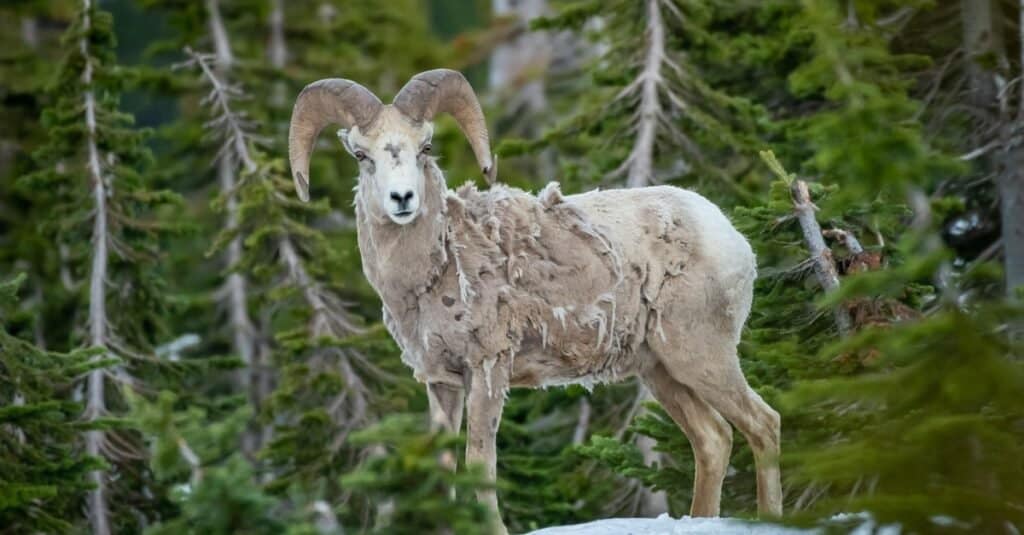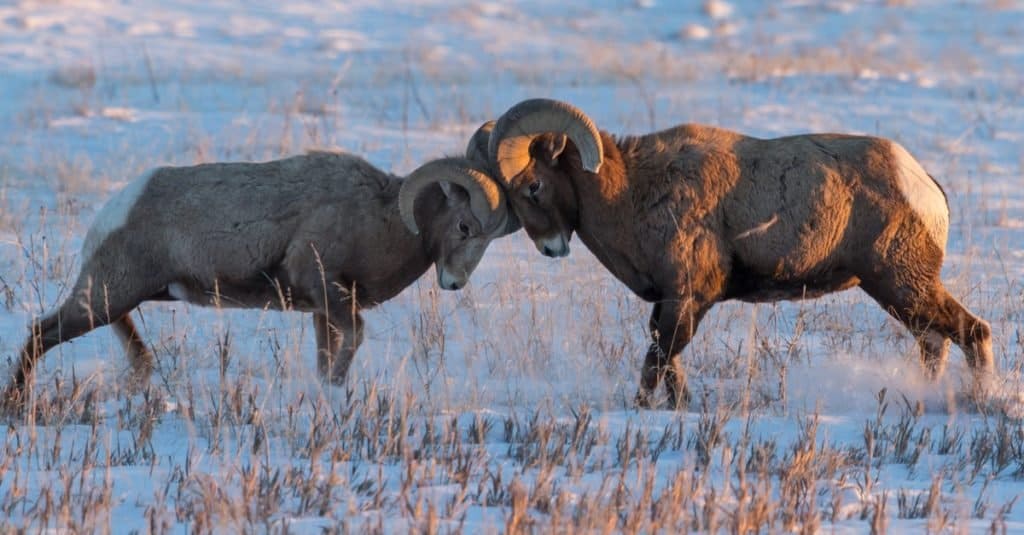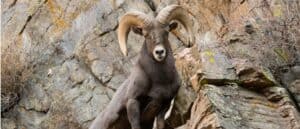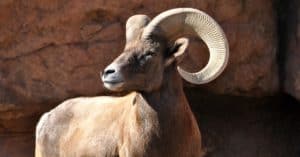As the eighth largest city in the U.S., Colorado is home to a variety of wildlife, which has earned it a spot for hunting and viewing. The animals inhabit the neighborhoods and wild lands and are a common phenomenon in the resident’s backyards.
Colorado has more than 960 species of wildlife, making it home to some of the most diverse wildlife occurrences in North America, with the bighorn sheep among the population.
Let’s find out the largest bighorn sheep ever caught in Colorado. We’ll also learn about the types of bighorn sheep in the state, their diet, their population, and where to find them.
The Largest Bighorn Sheep Ever Caught in Colorado
The largest bighorn sheep ever caught in Colorado scored a record of 197-7/8. The West Ward hunters in the West Ward region made the kill in 1998. But in 2017, hunter David J. Waldner killed a giant bighorn sheep of 193-2/8, the most recent highest record in the state.
While there are no official records yet, the death of one of the largest rams in Colorado could be a game-changer in world records by its initial measurements. The results will be recorded after a proper drying process that requires at least 60 days.
According to biologists, the ram was around 12-13 years old and died from old age. One of its horns had broken at the tip, which may be the only hindrance for the ram holding the new world record.
Its long life and prominent features are attributed to seclusion since it lived along the Arkansas River, which is pretty hidden from predators and has enough water and forage. However, on various occasions, it was spotted on private property near Pueblo Reservoir in the company of other rams.
The Largest Bighorn Sheep Ever Recorded in the World
The current world record for the largest bighorn, according to Boone & Crockett, had a score of 216-4/8 back in 2016.
The animal died of natural causes at a state park in Montana and was nine years old. It exceeds Alberta’s previous record of a bighorn by nearly seven inches. The record gives Montana three of the top 10 bighorn world records.
Scientists attribute this to great conservation partnerships, the availability of public land, and the best critical habitats.
Bighorn Sheep Varieties in Colorado

In North America, only two sheep species have large horns: the bighorn and the Dall sheep.
©iStock.com/kellyvandellen
Bighorn sheep have compact and muscular bodies and are primarily chocolate brown with a bit of white at the belly, rump and muzzle.
The females mostly weigh between 160-250 pounds, while their male counterparts may weigh over 350 pounds with a height of about 40 inches at the shoulder. They have wide eyes strategically positioned at the head, offering a wide arc of phenomenal vision. The bighorn’s extraordinary vision, sense of smell, and impeccable hearing abilities aid in detecting and avoiding its predators.
In North America, only two sheep species have large horns: the bighorn (the most popular) and the Dall sheep.
The bighorn sheep can be classified under three categories:
- Desert Bighorn
- Sierra Nevada
- Rocky Mountain Bighorn Sheep
The male sheep, the rams, possess large, curved horns weighing over 30 pounds. Older rams’ horns can grow as massive as three feet in length with a circumference of over one foot at the base. On the other hand, the female sheep, also known as ewes, come with shorter horns that have a slight curve.
This sheep species is also good at climbing steep terrains because of its hooves. While the outer hooves have toenails designed to block any protrusion, the inner hooves are soft and adapt to each surface, providing a firm grip at all times.
Bighorn Sheep Diet
During warm months, the bighorn sheep feeds on grass, sedges, and clover. It changes its diet during winter to woody plantations such as sage and willow. In desert regions, it feeds on plants like cacti and holly.
Since bighorn sheep are ruminants, the herbivores’ horned animals come with a stomach with four chambers. This allows them to eat plenty before retreating to their hideout habitats and rechewing the food. During digestion, it absorbs moisture, enabling them to stay longer without water.
The Bighorn Sheep Population in Colorado
At the peak of the industrial development in Colorado, the bighorn sheep population started to dwindle because of the elimination of their habitat through encroachment, hunting, and new diseases from domesticated sheep. These diseases included chronic frontal sinusitis, scabies, foot rot, pneumophilic bacteria, parainfluenza 111, contagious ecthyma, internal nematode parasites, and bluetongue.
By 1950, most bighorns in Colorado had been killed, and only an estimated 2,200 remained, the lowest number ever recorded in the state.
Under new management in the mid-1950s, the Colorado Division of Wildlife did massive research and later reintroduced large herds. Because of the reintroductions and new management policies such as seasonal restrictions and regulated harvest and hunting, the numbers increased, and there is currently an estimated population of 7,000 bighorn sheep.
Where to See Rocky Mountain Bighorn Sheep in Colorado
The bighorn sheep spend the better part of the year in the remote, harsh, and steep cliffs that can be hard for many people to access. The ewes, lambs, and yearlings mainly occur in nursery groups, while the rams can be found in separate groups known as bachelor bands. They prefer these regions because they can easily spot their predators and flee.
But the groups come together at a courtship ground in late November-January for the yearly mating season. During this season, the horned animals tend to be dramatic and active, creating a perfect opportunity for wildlife viewing.
While here, the rams tend to show their might by charging and shoving each other while they display their horns. They do this while following the ewes around to gauge their breeding readiness. In most cases, the biggest and most experienced rams win the battle and are accepted for mating by the females.
Here are other areas to spot the bighorn sheep in Colorado.
Garden of the Gods Park
Located in Colorado Springs, this park is home to the bighorn sheep herd and gets over two million visitors annually. In most cases, the visitors will see rams and ewes rattling and jumping through the fences. The park stands on 1,367 acres of land, and no prior reservation or visitation fee is required.
For an average visitor, it takes between 90 minutes to two hours to explore the park, particularly when driving. But it may take more time if you engage in other activities in the park, such as hiking and rock climbing. The recommended visiting hours are early morning and later in the day to avoid huge crowds.
Arkansas River
Another place to find the bighorn sheep in Colorado is the Arkansas River which flows through the Colorado State Park. This place has fantastic mountain views from the upper section of the river. Apart from the Rocky Mountain bighorn sheep, other native wildlife at the Arkansas River includes the Colorado mule deer, mallards, Canadian geese, bald eagles, golden eagles, black bears, ducks, great horned owls, elk, and mountain goats.
Apart from the wildlife, you can also fish at the river since it has around 80 miles of public access to catch various fish species like rainbows and brown trout. This river is among the few in Colorado with a high brown trout population, making it attractive to fishermen.
Glen Eyrie Castle
You can also catch the wild horned animals at Glen Eyrie Castle. Since it is next to the Garden of the Gods, the bighorn sheep easily crossover and roam the lawns of the castle.
Glen Eyrie is a gateway that offers deluxe and exclusive accommodation. It is also a great space for holding events such as conferences, weddings, and daytime meetings.
Pikes Peak
If you drive by the Pikes Peak highway, you will likely spot the horned sheep. With a mountain environment, it is also home to other wild animals, such as the marmots and the mountain goats.
Pikes Peak highway has a breathtaking winding road perfect for cycling and hiking through the Manitou Incline or opting for the Barr Trail.
You can also use the Cog Railway for a more exhilarating view or explore with tour companies that enable their clients to enjoy the views in those areas via a jeep or shuttle bus.
Bighorn Sheep Hunting in Colorado

In the 18th century, the bighorn sheep were endangered — this is no longer the case.
©Warren Metcalf/Shutterstock.com
Bighorn sheep hunting is allowed in Colorado but only to licensed residents. But there is a restriction by the Colorado Department of Wildlife regarding providing licenses for hunting these animals. Also, the State limits the number of sheep harvested annually to 100-300.
In 2011, there were more than 12,000 applicants for the hunting program in the state, but only 200 permits were issued.
At Pikes Peak, 97 people applied for the permits, but only two were issued for that area. The hunting season in Colorado is in autumn. Therefore, only less reproductive and mature sheep are offered for harvesting.
To be awarded a hunting license, one must show proof of at least six months of residency in Colorado. In addition, younger hunters between the ages of 12-15 need to take a hunter’s safety course by the state and should be under the supervision of an adult throughout.
Solly hunting is allowed for the older ages of 16 years and above. Licensed hunters are required to fill out a questionnaire before the end of the hunting season, failure of which you establish a reason for future license denial.
The applicant must indicate the bighorn sheep species they wish to hunt during the license application. Hunting starts before sunrise and ends a few minutes to sunset. Each hunter can only harvest one bighorn per season. Once your hunt becomes a success, you can only apply for another hunting experience after five years.
Hunting equipment is limited to non-mechanical draw where the arrows should be between seven to eight inches with broad heads with at least two serrated edges. The rifles must have at least 24 calibrations, be 26 inches in length, and have a barrel of 16 inches. Automatic discharge firearms are prohibited.
Are Bighorn Sheep Endangered in Colorado?
In the 18th century, the bighorn sheep were endangered due to extreme hunting, diseases, and encroachment of their homes, but that is not the case anymore.
However, North American Wildlife Conservation developed a model that limits hunting and fishing in the region. Through funds that wildlife conservation gets from selling fishing and hunting licenses, they can invest in wildlife research, management, and habitat improvement.
Key Takeaways
Many flock to Colorado to view bighorn sheep, boosting the state’s economic fortunes.
For those who love hunting, you can also enjoy the sport in Colorado with your children as long as they are above 12 years old. You’ll need a hunting license and must have been a Colorado resident for at least six months.
Destruction of wildlife habitat through encroachment is one of the reasons that led to the decline of bighorn sheep numbers back in the day. However, with proper management, habitat conservation has tremendously impacted the increased numbers of sheep.
Where is Ward, CO Located on a Map?
Located in Boulder County, Colorado, Ward is a home rule municipality that was founded in 1860 as a mining settlement following the gold discovery in the neighboring area of Gold Hill; with a population of 150 according to the 2010 census, it remains a testament to its historic roots.
Here is Ward, CO on a map:
Up Next
- Discover the 8 Largest Animals in Colorado and Where You’ll Find Them
- The 8 Best Lakes for Ice Fishing in Colorado
- Are There Grizzly Bears in Colorado?
The photo featured at the top of this post is © Georgia Evans/Shutterstock.com
Thank you for reading! Have some feedback for us? Contact the AZ Animals editorial team.





